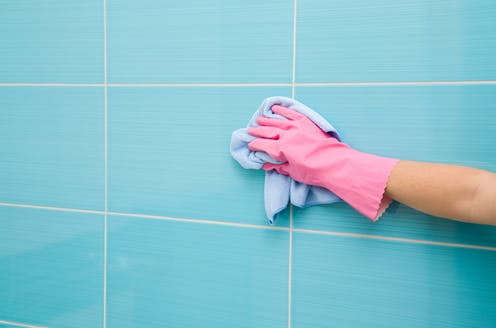This spring cleaning season is taking on a whole new meaning, there’s a lot more than just de-cluttering at stake. A clean home could be your last line of defense against a corona virus (COVID-19) pandemic infection. Large parts of the world are under various levels of stay-at-home and lockdown orders. To help separate fact from fiction, for expert advice on what, how, and when to clean. Even if you’re staying home, someone from every household has to venture out to get food and medicines and therefore possibly runs the risk of bringing home the virus along with the groceries. CoV-2, the virus which causes COVID-19 is believed to be able to persist on surfaces such as glass, metal, and cloth.
Experiments looking at similar viruses demonstrated persistence for hours to days. That means it’s possible to contract the virus if a surface in your home has been contaminated. Disinfecting and cleaning everyday surfaces is a great place to start your spring cleaning. So what should you be doing to keep yourself and your family safe during this stressful time? There’s plenty of misinformation out there and people are peddling products that can be harmful, not helpful. We’ve rounded up the practical, science-based and accepted practices that you’ll want to follow, especially as avoidance and disinfection are currently our only weapons against getting the disease and transmitting it to others.
Let’s start with,

What is cleaning vs. Disinfecting?
Yes, there is a difference and it can be a big one when it comes to safeguarding against the virus. These are the differences, but according to the Centers for Disease Control you want to do both, even if you’re in a currently healthy household:
Cleaning is the process that removes dirt and contaminants from surfaces while disinfecting is the act of killing pathogens that can make you sick. As the CDC recommends, you need to do both. In general, if you are at home and no one has left the house, proper hand washing and regular house cleaning, along with once-a-day disinfection of high touch areas, will be enough, Once anyone leaves the house and returns, you need to clean as well as disinfect to kill any viruses that may have come in.
Focus on the home’s hot zones
While the risk of transmission is greatest from person to person, scientists have shown that the coronavirus that causes COVID-19 can live on surfaces for varying amounts of time. A recent study found that the COVID-19 coronavirus can survive up to four hours on copper, up to 24 hours on cardboard, and up to two to three days on plastic and stainless steel. The experts also say that we still don’t know how the virus and its survival is affected by exposure to sunlight, heat, or cold.
Because it can survive on surfaces, this is why you need to disinfect the areas of the home that are most likely to harbour germs and viruses. These spots are likely to be in the high traffic areas of your home moves through frequently. These “high-touch” areas include:
- Doorknobs
- Table and countertop surfaces
- Hard surface chairs
- Bathroom surfaces
- Faucets and tap handles
- Toilets seats and handles
- Light switches
- TV remote controls
- Telephones and mobile phones
- Game controllers
- Car door handles and steering wheels
- Handbag/purse handles
- Counter-tops, desks, tables
- Handles of cupboards, drawers, appliances
- Bathtub, shower
- Remote controls
- Towels, sheets, clothing
- Phones, tablets, keyboards, etc.
- Deep clean to pass the time
Experts say that you want to simply clean the area first with soap and water or a cleaning spray (for non-electronics) and then use a disinfectant, whether that is a spray, bleach solution or disinfecting wipe. Whenever cleaning, wear disposable gloves or rubber gloves. If you use reusable rubber gloves, when you’re finished cleaning wash your gloved hands first, remove them, and wash your bare hands.
How to kill the corona virus in your home
Surfaces inside your home would only be compromised if someone with corona virus has been in the house. But because symptoms can take so long to appear, it’s better to be safe than sorry. Clean high-traffic areas like, this would include the bathroom, kitchen and frequent door handles and other surfaces the person would potentially contact. Think of your normal routine in the house and the surfaces you frequently touch and this will give you an idea where you need to disinfect. If someone in your home does have COVID-19, or at this point any kind of cold, you’ll want to disinfect these surfaces a few times a day.
The Centers for Disease Control and Prevention (CDC) recommends cleaning a surface (reducing the number of germs) and then disinfecting it (killing the remaining germs). The CDC also advises people to use disposable gloves during the process. To kill viruses, it’s best to use products specifically endorsed by the Environmental Protection Agency (EPA) to use against SARS-CoV-2. There’s a fair chance you already have these in your cupboard, as familiar brands like Lysol and Clorox are on the list. You can also dilute bleach or use alcohol solutions (with 70% alcohol or more). For soft surfaces like carpets or rugs, follow typical instructions for cleaning and wash what you can in warm water.
What is a Disinfectant?
As we’ve noted, a disinfectant is a substance that will kill pathogens on a surface. The US Environmental Protection Agency has a list of the disinfectants that will kill the virus, which was recently expanded during the pandemic. In fact, disinfectants are regulated and registered by the EPA, so products that contain them will have an EPA registration number on the label. Not all antibacterial wipes will necessarily work because bacteria and viruses are two different things. You have to check the labels because most are also disinfectants.
When spraying a surface with disinfectant, let it sit for a few minutes before wiping it away to give it time to kill the virus. Some experts also suggest letting it air dry if possible for the greatest effectiveness.
Some of the most commonly used disinfectants are wipes, sprays, isopropyl alcohol and hydrogen peroxide. Of course, along with hand sanitizer, these items are in high demand and short supply in the stores. If you can’t find store-bought products, you can still do a good job of keeping important surfaces clean and disinfected. Soap, water and some elbow-grease (scrubbing) go a long way in keeping things clean. Beyond that, in a pinch, you can make your own cleaning solution with household bleach.
The 10 most important things to disinfect regularly
While the nation is encouraging social distancing, it’s easy to go stir crazy. A great way to feel productive and pass the time is by deep cleaning your home. If you spend part of your day on a bigger cleaning project, you’ll also feel better about the evening hours you spend binge-watching a TV show. Now’s the time to do the tasks you normally wouldn’t bother with, or perhaps only do once a year.
In the kitchen, you can pull everything out of your fridge or freezer and clean the appliance. This is also a great time to do some inventory, check expiration dates, and maybe stock up on things like frozen produce and protein.
You can also do all those little tasks you’ve been putting off. Like hanging a piece of art, changing the light bulbs, finishing painting a room or completing that Pinterest craft you bought all the supplies for.
Spring is the perfect time to get started on yard work in preparation for summer. This is also a great way to get some fresh air and mild exercise. Plant your seedlings, spray down and clean lawn furniture, prune the shrubs, aerate your lawn, etc.
We’d also recommend doing a deep clean of your bathtub, for some much-needed self-care soaks. And vacuuming under furniture, like your bed and couches, can help with dust or allergies, and be a good chance to rearrange your space for more room while you’re quarantined.
A self-quarantine cleaning checklist
- Dust, pretty much everywhere
- Deep clean the oven, microwave and sink
- Organize your junk drawers
- Clean or replace the shower curtain
- Polish stainless steel surfaces and wood furniture
- Clean air vents
- Wash pillows
- Clean reusable grocery bags
- Clean the windows and mirrors
- Clean your makeup and brushes
- Clean blinds and window hangings
- Get at that grout in the bathrooms and kitchen
- Turn and vacuum your mattresses
- Clean out trash cans
- Deep clean the drains in the kitchen and bathrooms
- Clean rugs, mats and carpets
- Wash and detail cars
- Clean the vacuum cleaner and other cleaning tools
A Few Other Things to Remember
1. There is nothing that you can drink or consume to prevent the virus.
2. Antibiotics alone will not work against viruses.
3. There is currently no “cure” or specific treatment for COVID-19.
4. Vaccines are being developed and scientists are racing to explore new drugs to fight the virus.
Some facts check about COVID-19
Here are the some facts that considering in this pandemic scenario of corona virus.
What if Someone in the Home Is Sick?
If someone in the house is sick, you need to take these precautions plus others. See these recommendations from the CDC .
What won’t work to kill the virus?
Vodka and other forms of regular alcohol. An early internet myth was that Tito’s vodka could be used as a disinfectant but the company has issued statements stressing that its product only has 40 percent ethyl alcohol compared with the 70 percent that is needed to kill the virus. The other thing that won’t work is vinegar. While many people have switched to cleaning with vinegar and baking soda to be more environmentally friendly, these are not disinfectants.
Do I Need to Wear a Mask?
The answer is no unless you are sick or immunocompromised. Plain surgical masks will not protect you from the virus and the effective N95 masks are in short supply and are desperately needed by health care professionals in hospitals who are in constant contact with sick patients. Good Housekeeping cites CDC recommendations that “people who have respiratory symptoms wear them to prevent others from getting sick, as face masks may help stem some bacteria, especially in confined spaces.”
Will Washing Clothes Kill the Virus?
For the most part, yes. Washing your clothes the regular way with the right amount of soap and drying them in a hot dryer is all you need to do. If someone at home is sick, make sure that you disinfect the laundry basket and any other surfaces that the dirty laundry may have touched. And, wash your hands after handling the laundry and avoid touching your face until after you do.
How Do I Disinfect My Phone?
As you already know, mobile phones are super germy because they go everywhere we go, we’re always touching them and putting them near our mouths, and very few people clean them regularly or properly. If ever there was a time to start, it’s now. Using a disinfecting is the easiest and most efficient way to clean it, and a cloth with an alcohol solution is the second-best option. It’s the same for tablets as well. When cleaning the phone, take off the case.
Clean the phone’s screen, any buttons and the back of the phone. Then clean both the inside and outside of the case before putting it back on the phone. It’s a good idea to do this daily, but it’s particularly important when you return from a trip to the grocery store or pharmacy, or anywhere outside the home.
If you want to clean your laptop, experts say that an alcohol solution is your go-to. Some laptop displays are plastic and using a disinfecting wipe on it could be harmful. Besides the screen, make sure to clean the keyboard and surrounding surfaces as well as the outside. The same holds true for desktop computers – but don’t forget the mouse and mouse pad!
Do I Need To Disinfect Produce?
The biggest viral threat in the grocery store is your fellow shoppers, so that means social distancing is necessary there too. As far as the items on the produce section are concerned, experts say that there is no evidence that food can transmit the virus. Those who are still uneasy about eating uncooked produce that dozens of people may have pawed through can simply wash it.
Do not ever use bleach – no matter how dilute – to clean food or food products. There are currently some articles online that advocate this. Bleach has risks of its own and should never be ingested. Moreover, if you’re going to cook the produce, the process will certainly kill any bacteria or viruses.
Do I Need to Worry About Packages?
Generally, no. The World Health Organisation has said that “The likelihood of an infected person contaminating commercial goods is low and the risk of catching the virus that causes COVID-19 from a package that has been moved, travelled, and exposed to different conditions and temperatures is also low.” Of course, you need to take into account the health of the delivery people who bring the package. If you’re worried about it, you can give the package a quick once-over with a disinfecting wipe. Most importantly, wash your hands after handling packages and mail.







Leave a Comment
You must be logged in to post a comment.